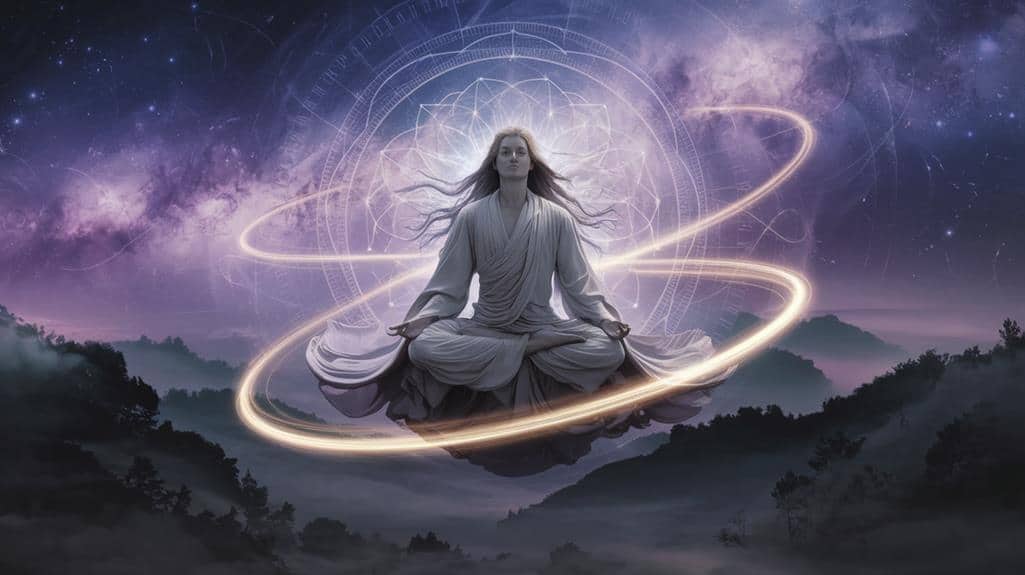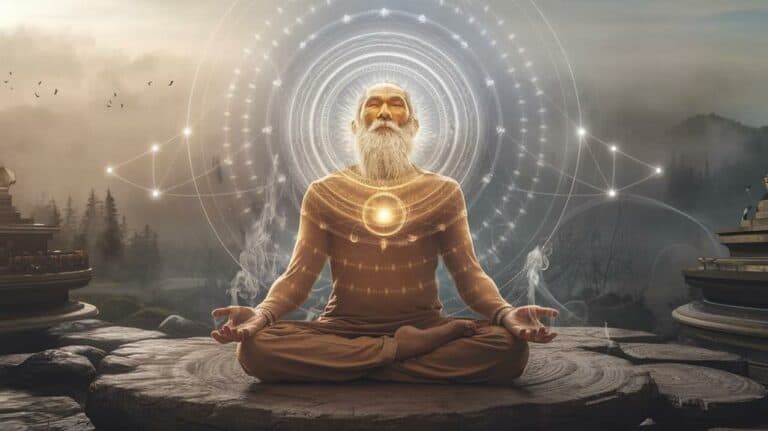The Role of Meditation and Contemplative Practices in Mysticism
When you first encounter the world of mystical practices, you’ll discover that meditation serves as more than just a tool for relaxation—it’s a gateway to profound spiritual experiences that have captivated seekers for millennia. Through contemplative techniques passed down through generations, you’re connecting to the same transformative practices that mystics, saints, and sages have used to pierce the veil between ordinary and extraordinary states of consciousness. While modern science now explains some of these phenomena, the deeper mysteries of meditation continue to intrigue both researchers and practitioners, offering glimpses into domains of experience that lie beyond conventional understanding.
Historical Origins of Mystical Practices
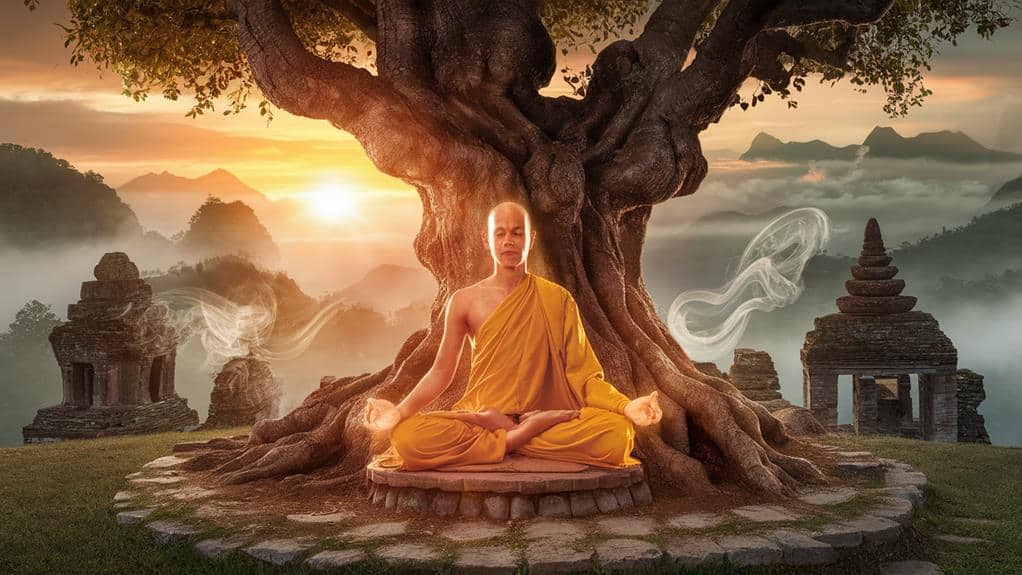
The origins of mystical meditation practices trace back over 5,000 years to ancient civilizations across Asia, the Middle East, and parts of Africa.
You’ll find that these early seekers discovered profound methods of inner exploration, developing techniques that would shape humanity’s spiritual journey for millennia to come. From the banks of the Ganges to the temples of Egypt, mystics crafted pathways to transcendent awareness through stillness, breath, and contemplation.
As you explore deeper into history, you’ll encounter the fascinating evolution of these practices across cultures.
The Vedic sages of ancient India developed sophisticated systems of meditation, while Taoist masters in China cultivated techniques for merging with the Tao. In the fertile valleys of Mesopotamia, priestesses and priests engaged in contemplative rituals that would influence Western mystical traditions.
These diverse origins haven’t remained static – they’ve flowed like rivers through time, merging and diverging, creating new tributaries of wisdom.
You’re inheriting these timeless practices that have been refined through countless generations of spiritual explorers, each adding their understanding to humanity’s collective quest for deeper meaning and connection with the infinite.
Understanding States of Consciousness
Mystics dive deep into exploring various states of consciousness during meditation, ranging from everyday wakefulness to profound transcendent experiences.
As you begin your contemplative journey, you’ll discover that consciousness isn’t a simple on-off switch but rather a spectrum of awareness that unfolds through dedicated practice. Each state reveals unique dimensions of reality and self-understanding, from the subtle whispers of your inner voice to the vast expanses of pure awareness.
You’ll find that these altered states aren’t merely psychological curiosities but gateways to deeper spiritual truths. Through regular meditation, you can learn to navigate between beta consciousness of normal waking life, through alpha and theta states of deep relaxation, and into the profound delta domain where mystics report their most transformative insights.
Your consciousness becomes like a finely tuned instrument, capable of perceiving subtle energies and transcendent realities that lie beyond ordinary perception. This expansion of awareness isn’t just about reaching higher states; it’s about integrating these experiences into your daily life, allowing you to maintain a broader perspective while engaging with the material world.
Sacred Breathing Techniques
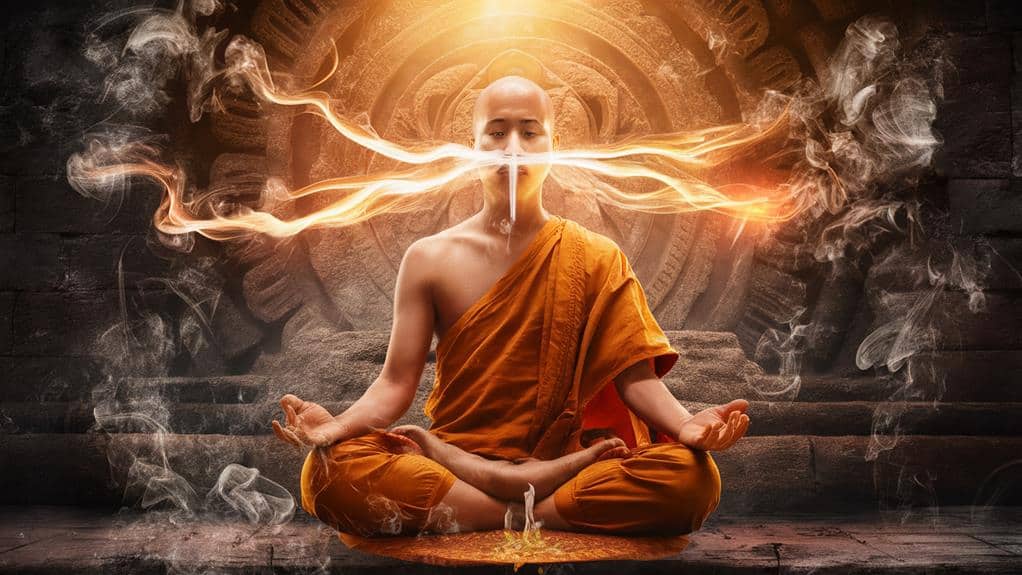
Through sacred breathing practices, you’ll discover powerful methods for altering consciousness and deepening your spiritual connection. As you explore these ancient techniques, you’ll encounter the transformative power of conscious respiration, which serves as a bridge between your physical existence and the ethereal dimensions of mystical experience. Your breath becomes a sacred tool, guiding you through the veils that separate ordinary awareness from profound spiritual insights.
When you engage in practices like pranayama or circular breathing, you’ll notice how each intentional breath creates subtle shifts in your perception. The rhythmic flow of inhalation and exhalation becomes a meditation in itself, leading you toward states of expanded awareness that transcend everyday consciousness.
You’ll find that specific breathing patterns can activate dormant energy centers within your body, awakening latent spiritual capacities that have remained dormant. As you master these techniques, you’ll develop an intimate understanding of how breath manipulation can induce altered states, from deep contemplative stillness to ecstatic spiritual experiences.
This mastery of sacred breathing becomes your gateway to direct mystical knowledge, offering you a practical path to transcendent awareness.
Cross-Cultural Meditation Methods
Wisdom from diverse spiritual traditions has given rise to a rich tapestry of meditation methods, each offering unique pathways to mystical awareness.
You’ll discover that Eastern practices like Zazen emphasize empty-mind sitting, while Vipassana guides you through detailed body scanning and present-moment awareness. These approaches reflect centuries of refined understanding about consciousness and its transformation.
As you explore Western contemplative traditions, you’ll encounter Christian hesychasm, where you’ll focus on the heart center while repeating sacred phrases, and Jewish Hitbodedut, which encourages spontaneous personal dialogue with the divine.
Islamic Sufi practices might draw you to whirling meditation or silent dhikr, teaching you to transcend ordinary consciousness through rhythmic movement or sacred remembrance.
In indigenous traditions, you’ll find meditation practices deeply connected to the natural world, where you’re invited to merge your awareness with the elements, often incorporating ceremonial drumming and sacred plant medicines.
Whether you’re drawn to Buddhist mindfulness, Hindu mantra recitation, or Taoist energy cultivation, each tradition offers you distinct tools for accessing deeper dimensions of consciousness and understanding your place within the cosmic order.
The Science Behind Mystical Experience
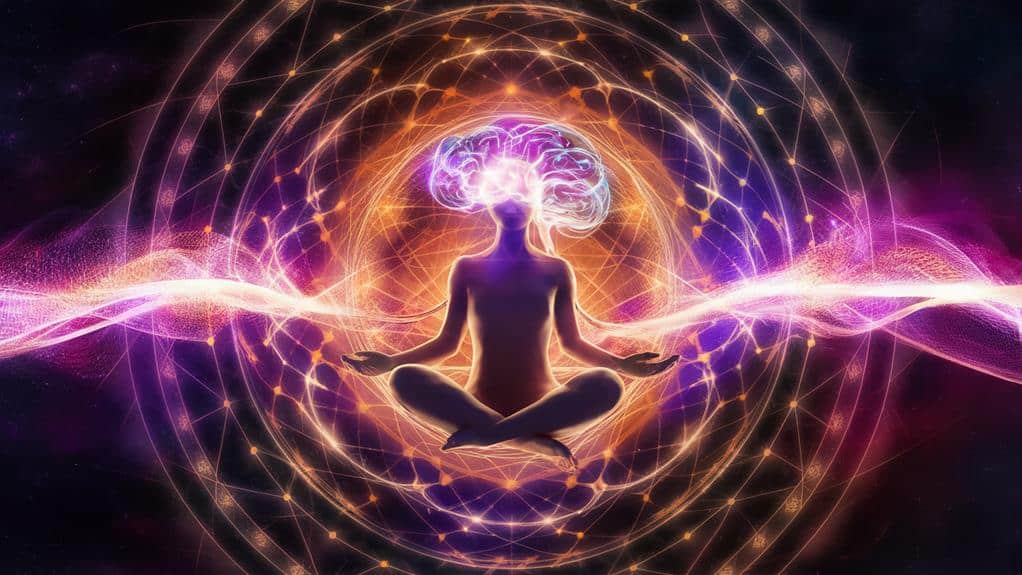
Modern neuroscience has explored deep into the biological foundations of mystical experiences, revealing how meditation alters brain function and consciousness. You’ll discover that during deep meditative states, your brain waves shift from beta to alpha and theta patterns, creating neural conditions similar to those observed in profound mystical encounters.
Research shows your default mode network – the brain’s “me center” – becomes less active, potentially explaining the dissolution of ego boundaries that mystics have described for millennia.
When you enter contemplative states, you’re actually changing your brain’s chemistry and structure. Scientists have documented increased activity in the prefrontal cortex, associated with attention and awareness, while the parietal lobe, which processes spatial awareness, shows reduced activity.
This explains why you might lose your sense of physical boundaries during mystical experiences. You’re not imagining these transformative moments – they’re reflected in measurable changes in your brain’s activity patterns, neurotransmitter levels, and even grey matter density.
Studies of long-term meditators reveal lasting alterations in brain regions governing emotional regulation, introspection, and sensory processing, suggesting that mystical experiences aren’t just temporary states but can permanently reshape your neural architecture.
Transformative Power of Silent Contemplation
Silence holds a mysterious power to reshape your entire being. As you sink into the depths of contemplative stillness, you’ll discover that silence isn’t merely the absence of noise – it’s a living, breathing presence that transforms your consciousness from within.
Through silent contemplation, you’re invited to witness the gradual dissolution of mental boundaries that have long confined your perception of reality. You’ll notice how your racing thoughts begin to settle, like sediment in clear water, revealing deeper currents of awareness that have always flowed beneath the surface of ordinary experience.
In these profound moments of inner quiet, you’re not just observing your thoughts – you’re transcending them. The transformative nature of silence operates beyond the domain of intellectual understanding, working directly on your consciousness at its most fundamental level.
As you continue to explore this contemplative path, you’ll discover that silent meditation isn’t just a practice – it’s a gateway to mystical dimensions of experience. Your awareness expands beyond the confines of personal identity, opening into vast spaces of consciousness where the ordinary boundaries between self and universe begin to blur.
Physical Effects of Spiritual Practice
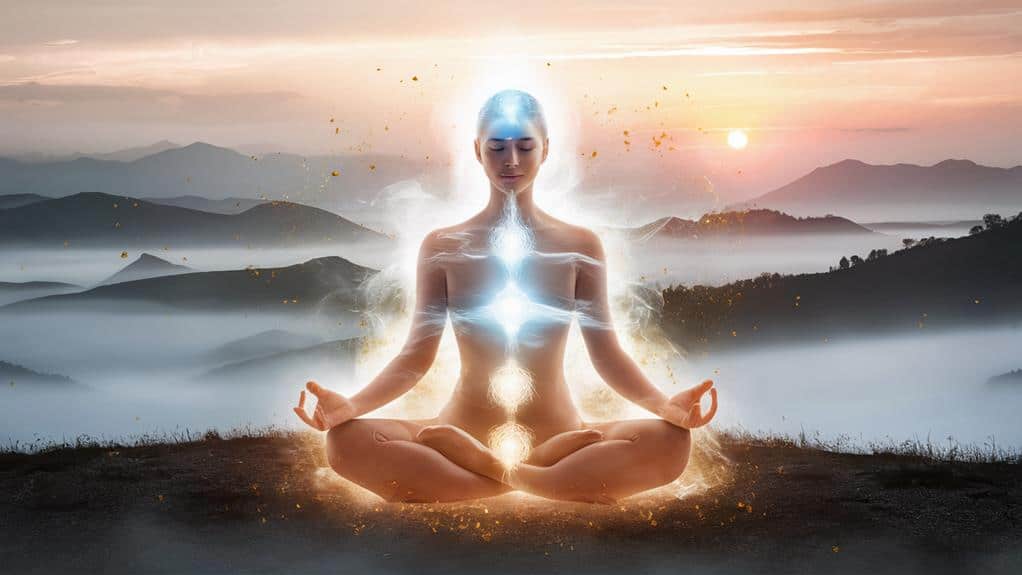
When you engage in sustained spiritual practices like meditation, profound changes begin to manifest in your physical body.
You’ll notice your breathing patterns shifting naturally toward slower, deeper rhythms, while your heart rate and blood pressure often decrease to more balanced levels.
Your nervous system gradually evolves from its typical fight-or-flight state into a restorative mode of deep relaxation.
As you continue your practice, you’ll discover that these physiological shifts extend beyond your meditation sessions.
Your immune system strengthens, inflammation markers decrease, and your brain structure actually changes – particularly in areas associated with attention, emotional regulation, and self-awareness.
You’re likely to experience improved sleep quality, enhanced cognitive function, and a natural reduction in chronic pain patterns.
These bodily transformations aren’t merely coincidental; they’re direct manifestations of your spiritual journey.
Your physical form becomes a living reflection of your inner work, demonstrating the inseparable connection between consciousness and matter.
Through consistent practice, you’re not just transforming your mind – you’re literally reshaping the temple that houses your spirit.
Modern Applications of Ancient Wisdom
Ancient meditative practices increasingly find their way into contemporary settings, from corporate boardrooms to scientific laboratories. You’ll find these time-tested techniques being adapted to address modern challenges, from stress management to enhanced creativity, as ancient wisdom meets cutting-edge neuroscience.
The intersection of traditional contemplative practices with modern research has revealed profound insights into the nature of consciousness and human potential.
You’re witnessing a remarkable synthesis as age-old mystical practices transform into evidence-based interventions. There’s a growing recognition that the contemplative traditions weren’t merely seeking religious experiences – they were developing sophisticated methods for exploring consciousness and revealing human capabilities.
Today, you can access these practices through mindfulness apps, workplace wellness programs, and therapeutic protocols that honor their mystical roots while serving practical needs. What your ancestors discovered through centuries of introspection now finds validation in brain imaging studies and psychological research.
You’re part of a generation that’s bridging the gap between esoteric wisdom and empirical understanding, as meditation emerges as a powerful tool for personal transformation in an increasingly complex world.
Preparing the Mind for Transcendence
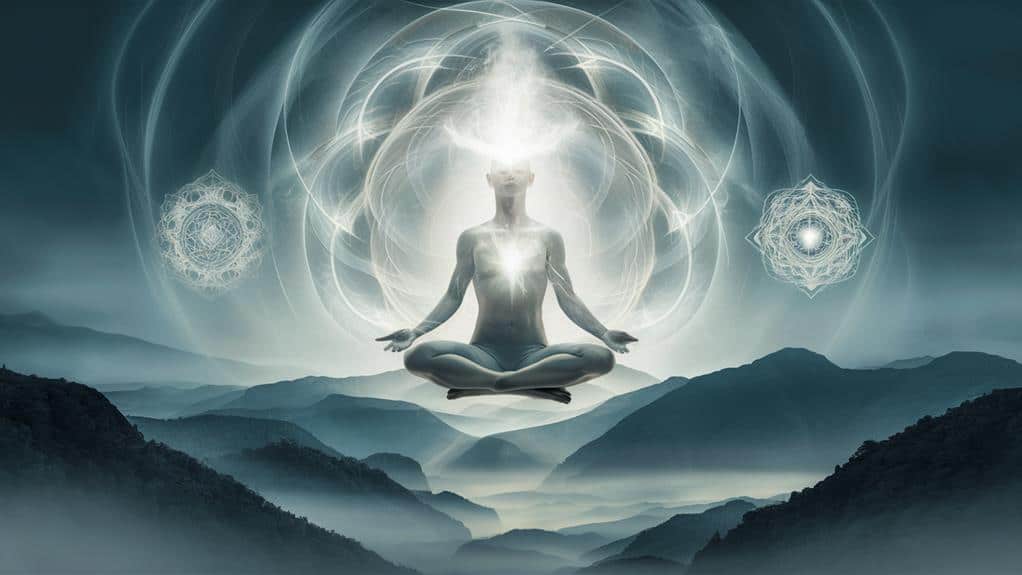
The essential first step toward transcendent meditation requires clearing away the mental clutter that obscures deeper awareness.
You’ll need to systematically release the day’s concerns, letting them drift away like autumn leaves on a gentle stream, until your mind becomes still and receptive to higher consciousness.
As you explore deeper into meditative practice, you’re learning to distinguish between surface thoughts and the profound undercurrents of consciousness that lie beneath.
Your awareness will naturally expand beyond the confines of ordinary perception, opening doorways to transcendent states that you’ve always sensed but couldn’t quite access.
Through patient cultivation of inner silence, you’ll discover that your mind isn’t just capable of observing reality – it’s an integral part of the cosmic fabric you’re exploring.
You’re now ready to embrace the paradox that true transcendence requires both complete surrender and unwavering focus.
Mystical Traditions Across World Religions
Mystical practices weave through every major world religion, revealing strikingly similar approaches to transcendent meditation despite their diverse cultural contexts.
You’ll find Sufi mystics whirling in divine ecstasy while Buddhist monks sit in silent contemplation, each seeking the same dissolution of ego and merger with ultimate reality. Through these varied paths, you’re witnessing humanity’s eternal quest for direct spiritual experience.
In Hinduism’s Vedantic traditions, you’ll encounter meditation techniques that parallel Christian contemplative prayer, where you’re guided to look beyond the surface of ordinary consciousness.
Jewish Kabbalah teaches you to ascend through spiritual dimensions, while Taoist practices show you how to align with the natural flow of universal energy. These traditions aren’t merely historical curiosities – they’re living pathways you can explore today.
When you investigate deeper, you’ll discover that whether it’s Islamic dhikr, Native American vision quests, or Orthodox Christian hesychasm, each tradition offers you tools to transcend ordinary awareness.
While their external forms differ, they’re all pointing to the same transformative truth: you can directly experience the sacred through dedicated contemplative practice.



